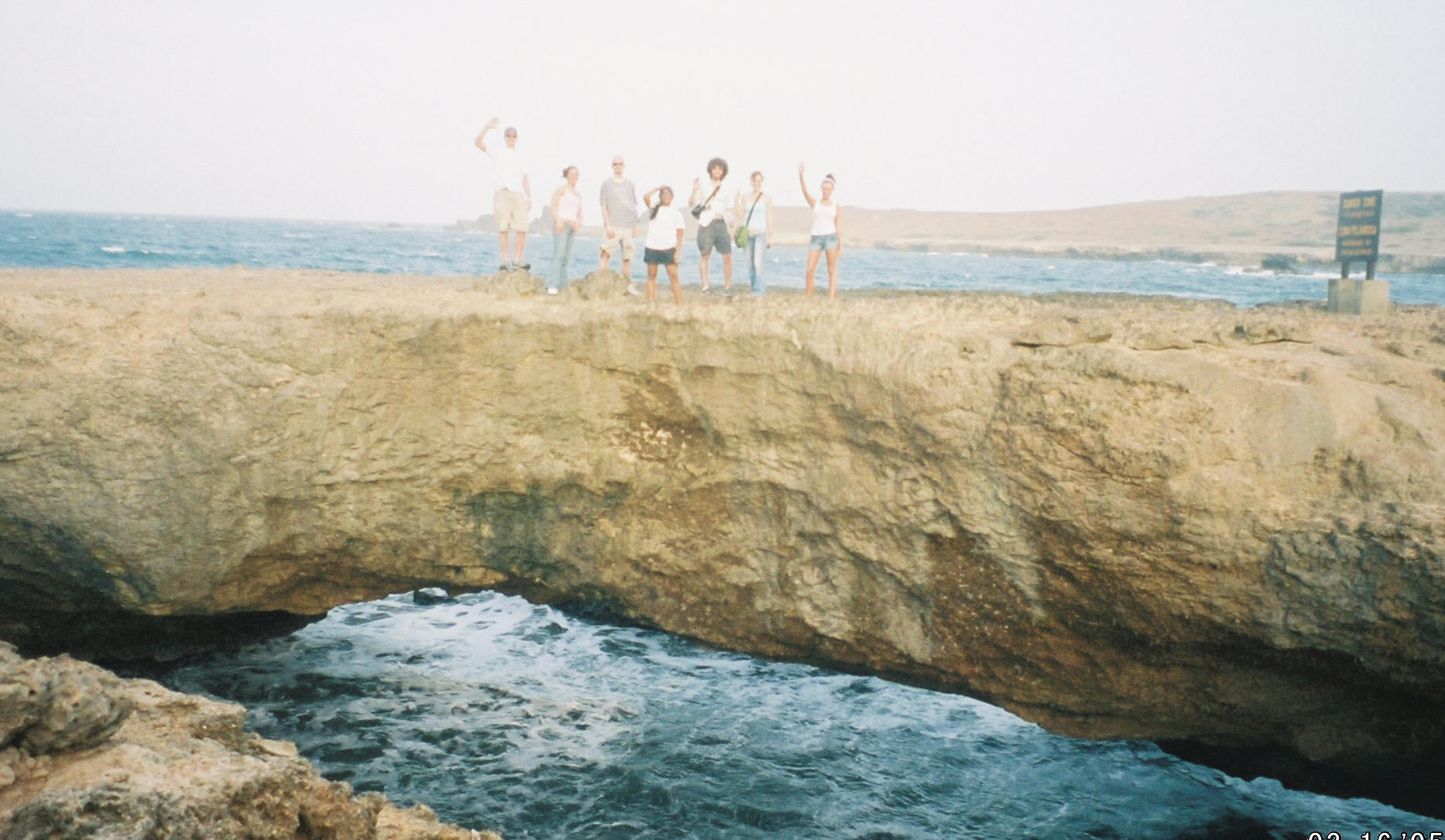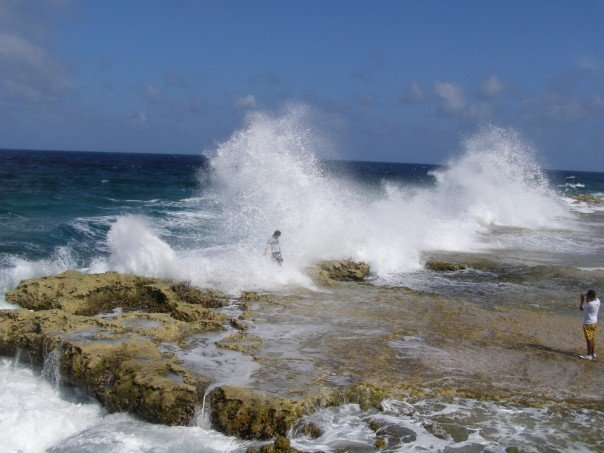
Marshall Tropical Ecology
Bonaire - March 2006
For more trip pictures, click here.
(Note: for all videos, please right click and "save target as" for best results.)
Click here for some extra project info.
Notes from a Journal...
15/16 March 06
This morning, I got out of bed at 2:30 am setting the tone for a long, arduous, sleep-depriving trip. We headed to the Charleston, WV airport for our first of many connections before reaching our final destination - Bonaire. For general information, Bonaire is one of the Dutch Antilles islands off the northern coast of Venezuela. The average annual temperature there is roughly 30 F warmer than the mean temp in Wild and Wonderful WV. So, as soon as we stepped off the plane, we immediately had to rethink our bulky winter clothing choices that were so kind to us in Charleston. About half the group was able to spend roughly 12 hours on Aruba, waiting on a connecting flight and seeing sights like the natural bridge and the Hooiberg. Eventually, the entire party made it to Buddy Dive resort in Bonaire.

17 March 06
Today several students finished up their open water certifications. The dive staff at Buddy Dive wanted to assess all our skills before cutting us loose on some of the most spectacular reef diving in the world. For most of us, this was the first chance to dive in a marine environment. For few, this was the first chance to dive. In the afternoon, a boat took us to Klein Bonaire - a small uninhabited island off the west coast of Bonaire proper. We followed our guide down to 50' where we were able to see such marine life as parrot fish, eels, wrasse, coral and a multitude of other marine life. A second boat dive finished up the afternoon. In the evening, we drove to a local supermarket where some supplies could be purchased. Dinner for the group varied from Pringles to mac and cheese to rice and beans.
18 March 06
This morning held the first terrestrial adventure in Bonaire for most of the group (some have been a bit more active than others). We drove the rental trucks to Washington Slagbaai National Park which is home to some spectacular bird diversity, herpetofauna and more incredible dive sites including the Bise Morto. After driving back from the park, we had two more boat dives. For dinner, we drove to Kralendijk for sushi. Two intrepid students set off for the first of many night dives. The aim of the dive was to capture video footage of the 6' piscivorous resident tarpon, nicknamed Charlie, at the Buddy Dive harbor. For some reason, swimming with a large silvery fish in the still, dark of night brings images of man-eating sharks to mind. Luckily Charlie was only interested in fish stunned by the high intensity underwater lights.
19 March 06
Two more boat dives began another long day in paradise. Students began learning underwater photography and videography. It will take a bit of practice to shoot clean, still images and video that does not induce nausea. Not surprisingly, a steady hand is one of the best assets to anyone interested in these pursuits. After the boat dives, we drove to the east side of Bonaire. If you leave the island from here and head due east, the first piece of land that you hit would be Africa. For this reason, the sea is much different than on the shielded west coast. Strong waves continually crash against a shore line composed of sharp igneous rock.

After this little adventure, we toured the southern half of the island. We got to see the world's only solar powered sea salt operation. An important but unfortunate part of Bonaire's history is centered around this industry. Just south of the salt fields were several small huts that housed the indigenous slaves that were forced to work there.
20 March 06
Diving today took place again in Washington Slagbaai. The park holds some incredible wildlife (both aquatic and terrestrial). Donkeys and goats (both introduced species) paraded through the middle of dirt roads as if the man-made trails were created for their benefit. Roads in the park left a bit to be desired, and in some cases it would have been very helpful to have 4x4 vehicles. More exploring and diving occupied our day.
21 March 06
Today was a "free day," and several student took the opportunity to do some things we knew we would not be doing as a group in Bonaire. Some felt it was necessary to catch up on much needed sleep. Others thought lounging by the pool and working on a not so hard to come by tan was the best way to pass the time. A group of students rented a motorboat that came equipped with water skis and a wake board. Shopping was a nice stress reliever for some while others continued on the hunt for one more after one more lizard. However the day was spent, it was a much needed break from the all-day action of the previous days and those yet to come. A night reef dive finished off the day for a group. Bioluminescent organisms were the highlight of the dive.
22 March 06
Birding was the scheduled event for this morning. To effectively bird watch, one must get up quite early, travel to the desired destination and stand motionlessly and silently for a very long time. The effort was not wasted, though, because some of the birds that were spotted were incredible. More diving followed the mornings activities. By this point students were accurately filing out dive surveys listing the types and population sizes of the fish spotted for each dive. The surveys will be compiled and turned in to REEF - an organization for ocean conservation. After dinner, the group was regaled by a guest lecture on some of the important issues on sea turtle conservation.
23 March 06
The morning was again spent birding. A comparison between inland species and waterfowl was conducted. Today was also the last day available for diving. Because of decompression limitations, it is not recommended to fly within 18 hours of the last dive. A small group of students set off with a highly ambitious plan to complete six dives. Time was devoted to meticulously planning dive depth, dive time, driving directions, and all the other aspects that could be controlled. Several dives were completed including a shipwreck (Hilma Hooker) and the famous night dive of the town pier. The only problem here arose when the number of students going on the dive was greater than the number of dive lights. It is only a little nerve-wracking to be underwater in complete darkness. When the group returned to the resort, a large mating population of sea wasps was in the harbor. That was reason enough to cancel the last planned dives for the night.
24 March 06
It was not business as usual this morning. No birding today; no diving either. We spent the day in community service on Klein Bonaire. The small island is the nesting location to Loggerhead and Hawksbill turtles. A boat dropped us off after breakfast and promised to return in time for dinner. After hours of picking up garbage on the island, we began to wonder about the boat captain's honesty. Eventually, we were retrieved, and we spent the evening packing up for the long trip home.
Created by S. Collins, February 2008